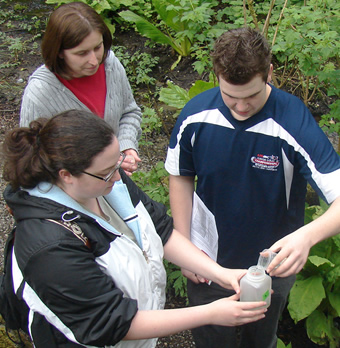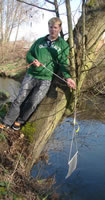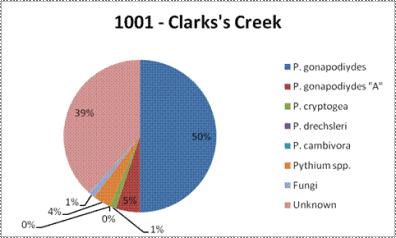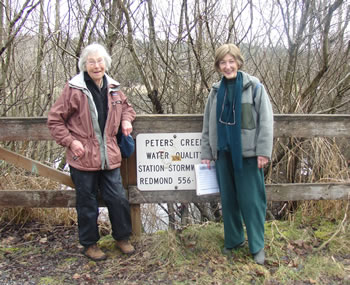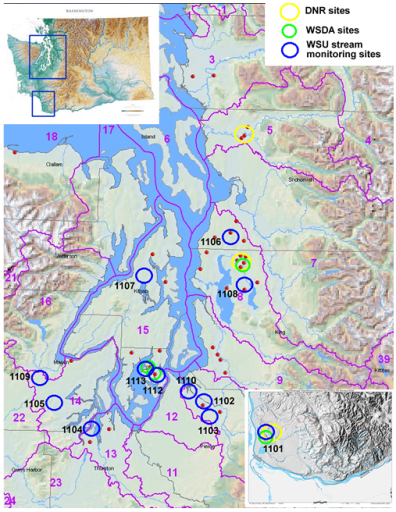Photos “bait in a bottle” method at Clarks Creek
gary.maguireResults of BOB sampling at Clarks Creek
gary.maguireResults of BOB sampling at Clarks Creek
The most commonly isolated group of Oomycetes was Pythium belonging to Clade B2. There was little difference among hosts, except for reed canarygrass from which only one Pythium sp. was isolated. Saprolegnia was isolated from three hosts. Two Phytophthoras belonging to Clade 6 were isolated, and these, as well as Pythiums in Clade B2, were commonly found at the other freshwater sites sampled in this study.
Phylogenetic trees from sequence data obtained in this study:
| Phytophthora | Pythium | Saprolegnia |
Host |
species isolated |
group or clade |
Riparian/forest |
# isolates |
|
| False lily of the valley | Maianthemum dilatatum | Fusarium spp. | fungus |
F
|
2
|
| False lily of the valley | Maianthemum dilatatum | Phytophthora taxon ‘salixsoil’ | 6 |
F
|
1
|
| False lily of the valley | Maianthemum dilatatum | Pythium diclinum/lutarium | B2 |
F
|
5
|
| Grand fir | Abies grandis | Phytophthora taxon ‘pgchlamydo’ | 6 |
F
|
1
|
| Grand fir | Abies grandis | Pythium aquatile | B2 |
F
|
1
|
| Grand fir | Abies grandis | Pythium diclinum/lutarium | B2 |
F
|
7
|
| Licorice fern | Polypodium glycorrhiza | Mucor hiernalis | zygomycete |
F
|
1
|
| Licorice fern | Polypodium glycorrhiza | Pythium aquatile | B2 |
F
|
1
|
| Licorice fern | Polypodium glycorrhiza | Pythium diclinum/lutarium | B2 |
F
|
2
|
| Licorice fern | Polypodium glycorrhiza | Pythium oopapillum | B2 |
F
|
1
|
| Rhododendron | Rhododendron ‘Nova Zembla’ | Pythium aquatile | B2 |
F
|
1
|
| Rhododendron | Rhododendron ‘Nova Zembla’ | Pythium diclinum/lutarium | B2 |
F
|
5
|
| Rhododendron | Rhododendron ‘Nova Zembla’ | Saprolegnia parasitica | Saprolegnia |
F
|
1
|
| Red alder | Alnus rubra | Pythium diclinum/lutarium | B2 |
R
|
5
|
| Red alder | Alnus rubra | Pythium oopapillum | B2 |
R
|
2
|
| Red alder | Alnus rubra | Pythium undulatum | H |
R
|
1
|
| Reed canary grass | Phalaris arundinacea | Pythium intermedium | F |
R
|
8
|
| Salmonberry | Rubus spectabilis | Pythium diclinum/lutarium | B2 |
R
|
8
|
| Salmonberry | Rubus spectabilis | Pythium oopapillum | B2 |
R
|
1
|
| Salmonberry | Rubus spectabilis | Saprolegnia parasitica | Saprolegnia |
R
|
1
|
| Skunk cabbage | Lysichiton americanum | Mortierella sp. | zygomycete |
R
|
1
|
| Skunk cabbage | Lysichiton americanum | Pythium diclinum/lutarium | B2 |
R
|
3
|
| Skunk cabbage | Lysichiton americanum | Saprolegnia diclina | Saprolegnia |
R
|
1
|
Contact: Gary Chastagner, 253-445-4528 | WSU Puyallup Research & Extension Center, 2606 West Pioneer, Puyallup, WA, 98371-4998 USA
Last updated January 2, 2013
Stream sampling using “bait in a bottle” method at Clarks Creek
gary.maguireStream sampling using ”bait in a bottle” method at Clarks Creek
Oomycetes are fungus-like organisms found in marine, freshwater, and terrestrial environments. Some, such as Phytophthora, Pythium, and Saprolegnia, are parasites of plants and animals. DNA sequence data has revealed that these organisms are not fungi, but are more closely related to brown algae and diatoms. We will be “fishing” for these organisms by using leaf baits from various plant species.
Objectives
- Is there a relationship between host bait material and Oomycete species isolated?
- Riparian vs forest plants – are riparian plants resistant to infection?
- Has P. ramorum made it to Clarks Creek?
Each group will choose a plant species to use for bait. Pick fully expanded leaves that are relatively free of spots or other signs of infection. Punch out 20 leaf discs and put in bottle. Include one intact leaf. Put leaf baits in bottle of creek water and cap tightly. Rest bottle on its side for incubation.
After incubation leaf baits will be cultured on selective media for Oomycetes, transferred to pure culture, and identified using DNA sequencing.
Clarks Creek Headwaters 1103
gary.maguireClarks Creek headwaters
Site #1103
Clarks Creek, near fish hatchery
This site also used for Pierce College “Bait in a Bottle” experiment.
Elevation 48 ft
2011-1102 Clarks Creek downstream
gary.maguireClarks Creek downstream
 |
 |
|
| Land use map |  |
Site #1102 Clarks Creek, Puyallup, WA
Elevation 24 ft Stream order 2
Clear/Clarks Creek Basin Plan 2006, Pierce County Public Works & Utilities USGS data for Clark’s Creek
Clarks Creek – headwaters
gary.maguire| Site # 1007Baiting at Clarks Creek upstream, near fish hatchery by Biology 213 class from Pierce College. 4/15/10.
see results of the Shoe Experiment here |
Clark’s Creek – downstream
gary.maguireClark’s Creek – downstream
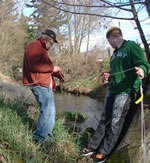 |
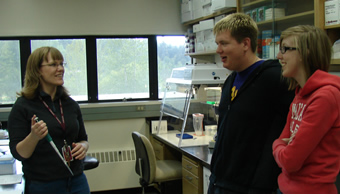 PHS students learning molecular identification techniques in the lab PHS students learning molecular identification techniques in the lab |
|
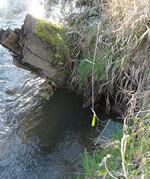 |
Site #1001First bait deployment March 3, 2010 by Puyallup High School students in Dave Wetzel’s class |
| Baiting period | Bait leaf spp. | Phytophthora spp. and others identified |
|
1
|
Rhododendron | P. gonapodyides (6), Trichoderma spp. (1) |
|
1
|
Camellia | P. gonapodyides (1), unknown (1) |
|
2
|
Rhododendron | P. gonapodyides (4), unknown (4) |
|
2
|
Gold dust plant (Aucuba japonica ‘Variegata’) | Pythium litorale or Py. sterilum (2) |
|
3
|
Rhododendron | P. gonapodyides (6), unknown (5) |
|
3
|
Strawberry tree (Arbutus unedo) | Pythium sp. or Py. undulatum (1), unknown (1) |
|
4
|
Rhododendron | P. gonapodyides (5), P. gonapodyides “A” (4), P. cryptogea (1), unknown (1) |
|
4
|
Dwarf cherry laurel | P. gonapodyides (2), unknown (2) |
|
5
|
Rhododendron | P. gonapodyides (7), unknown (5) |
|
5
|
unknown (2) | |
|
6
|
Rhododendron | P. gonapodyides (4), unknown (8) |
|
6
|
Red tip Photinia | P. gonapodyides (2) |
Viewing Chum Salmon in Clark’s Creek
WDFW 2000 Clear/Clark’s Creek Basin Plan Pierce County 2005
Pink salmon in Clarks Creek near Puyallup NWIFC Blog Sept. 2007
2011 Stream Monitoring Results
gary.maguire2011 Stream Monitoring Results
This project provided baseline information about oomycetes in western Washington streams. Some very common species that were ubiquitous in all streams in large numbers were identified, as well as some more rare species only found in certain streams. Several putative new species were also detected. The table below shows the locations of western Washington streams monitored in this study. Simpson’s diversity index (D) was calculated for each site based on the number of isolates and species of oomycetes detected. Values close to 0 indicate higher species diversity.
| Stream ID | Name | County | Land use | Total number of isolates | Total number of species | Simpson’s diversity index (D) |
| 1101 | Packard Creek* | Clark | Agriculture/residential |
25 |
11 |
0.1333 |
| 1102 | Clarks Creek | Pierce | Agriculture |
9 |
6 |
0.1111 |
| 1103 | Clarks Creek | Pierce | Fish hatchery, residential |
15 |
8 |
0.2095 |
| 1104 | Woodard Bay | Thurston | Conservation area, brackish |
29 |
5 |
0.6823 |
| 1105 | Goldsborough Creek | Mason | Forest/residential |
31 |
7 |
0.428 |
| 1106 | North Creek | Snohomish | Suburban/residential |
22 |
9 |
0.0996 |
| 1107 | Clear Creek | Kitsap | Urban/commercial |
20 |
8 |
0.1526 |
| 1108 | Peters Creek | King | Urban/commercial |
22 |
6 |
0.2035 |
| 1109 | Vance Creek | Mason | Undisturbed forest |
25 |
4 |
0.3833 |
| 1110 | Thea Foss Waterway | Pierce | Formerly industrial, heavily polluted, brackish |
39 |
3 |
0.5196 |
| 1112 | Wollochet Creek* | Pierce | Suburban/residential, ditch adjacent to former nursery site |
23 |
5 |
0.332 |
| 1113 | Rosedale Creek* | Pierce | Suburban/residential |
16 |
8 |
0.1417 |
* Known to contain Phytophthora ramorum from WSDA or DNR baiting
Stream monitoring sites 2011
gary.maguireStream monitoring sites 2011
King County
Mason County
Pierce County
Thurston County
Clark County


















